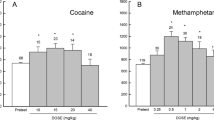Abstract
It has been shown that pretreatment with dopamine (DA) receptor blockers disrupts the effect of intravenously (IV) and intracerebrally (ICV), but not intraperitoneally (IP) administered cocaine on place preference conditioning (PPC). The present study was undertaken to further evaluate possible differences between IV and IP cocaine PPC. To this end, several factors which may differentially influence IV and IP cocaine PPC were examined. Firstly, dose-response effects were studied. Intravenous cocaine produced PPC within a narrow dose range (0.5–2.5 mg/kg). Animals receiving IV injections of 5 and 10 mg/kg cocaine experienced convulsions and did not show PPC. For IP cocaine a 10-fold increase in dose (10 mg/kg) and twice the number of training trials was required in order to obtain PPC equal in magnitude to that with IV cocaine (0.5 mg/kg; two trials). Cocaine PPC was retained at least 1 month. Following IV cocaine preference developed for the side associated with the drug regardless of whether the conditioning was to the least or most preferred side. After IP cocaine, preference developed for the drug side only when the drug was paired with the least preferred side. Rats trained with IV, but not IP, cocaine significantly preferred the drug familiar side to a novel compartment. Preference for the IV or IP cocaine side developed regardless of whether testing was carried out in the drugged or undrugged state, excluding possible state-dependent effects as an explanation of the cocaine PPC. The results show PPC procedure to be a valid test for evaluating rewarding properties of IV cocaine. However, they fail to show rewarding effects of IP cocaine.
Similar content being viewed by others
References
Bardo MT, Miller JS, Neisewander JL (1984) Conditioned place preference with morphine: The effect of extinction training on the reinforcing CR. Pharmacol Biochem Behav 21:545–549
Berlyne DE (1969) The reward value of indifferent stimulation. In: Tapp JT (ed) Reinforcement and behavior. Academic press, New York, pp 179–214
Fibiger HC (1978) Drugs and reinforcement: a critical review of the catecholamine theory. Ann Rev Pharmacol Toxicol 18:37–56
Mackey WB, van der Kooy D (1985) Neuroleptics block the positive reinforcing effects of amphetamine but not of morphine as measured by place conditioning. Pharmacol Biochem Behav 22:101–105
Mackintosh NJ (1974) The Psychology of animal learning. Academic Press, London New York San Francisco
Martin-Iverson MT, Ortmann R, Fibiger HC (1985) Place preference conditioning with methylphenydate and nomifensine. Brain Res 332:59–67
Mithani S, Martin-Iverson MT, Phillips AG, Fibiger HC (1986) The effects of haloperidol on amphetamine- and methylphenidate-induced conditioned place preferences and locomotor activity. Psychopharmacology 90:247–252
Moore KE, Chieuh CC, Zelds G (1977) Release of neurotransmitters from the brain in vivo by amphetamine, methylphenidate and cocaine. In: Ellinwood EH Jr, Kilbey MM (eds) Cocaine and other stumulants. Plenum Press, New York, pp 143–160
Morency MA, Beninger RJ (1986) Dopaminergic substrates of cocaine-induced place conditioning. Brain Res 399:33–41
Mucha RF, Iversen SD (1984) Reinforcing properties of morphine and naloxone revealed by conditioned place preference: a procedural examination. Psychopharmacology 82:241–247
Mucha RF, van der Kooy D, O'Shaughnessy M, Bucenieks P (1982) Drug reinforcement studied by the use of place conditioning in rat. Brain Res 243:91–105
Overton DA (1978) Major theories of state dependent learning. In: Ho B, Chute D, Richards D (eds) Drug discrimination and state dependent learning. Academic Press, New York, pp 283–318
Pickens R, Dougherty JA (1972) A method for chronic intravenous infusion of fluids in unrestrained rats. Reports of Research Laboratories, Department of Psychiatry, University of Minnesota, Report No PR-72-1
Pickens R, Thompson T (1968) Cocaine reinforcement behavior in rats: effects of reinforcement magnitude and fixed-ratio size. J Pharmacol Exp Ther 161:122–129
Roberts DCS (1978) On the role of catecholamines in the reinforcing and punishing properties of stimulants and opiates. PhD Thesis, Faculty of Graduate Studies University of British Columbia
Sherman JE, Pickman C, Rice A, Liebeskind JC, Holman EW (1980a) Rewarding and aversive effects of morphine: Temporal and pharmacological properties. Pharmacol Biochem Behav 13:501–505
Sherman JE, Roberts T, Roskam SE, Holman EW (1980b) Temporal properties of the rewarding and aversive effects of amphetamine in rats. Pharmacol Biochem Behav 13:597–599
Spyraki C (1987) Drug reward studied by the use of place conditioning in rats. In: Lader M (ed) Psychopharmacology of addiction. Academic Press (in press)
Spyraki C, Fibiger HC, Phillips AG (1982a) Cocaine induced place preference conditioning: Lack of effects of neuroleptics and 6 — hydroxydopamine lesions. Brain Res 253:195–203
Spyraki C, Fibiger HC, Phillips AG (1982b) Dopaminergic substrates of amphetamine-induced place preference conditioning. Brain Res 253:185–193
Spyraki C, Kazandjian A, Varonos D (1985) Diazepam-induced place preference conditioning: Appetitive and antiaversive properties. Psychopharmacology 87:225–232
Spyraki C, Nomikos GG, Varonos DD (1987) Intravenous cocaine-induced place preference: Attenuation by haloperidol. Behav Brain Res (in press)
Stolerman IP, D'Mello GD (1981) Oral self administration and the relevance of conditioned taste aversion. In: Thompson T, Dews PB, McKim WA (eds) Advances in behavioral pharmacology, Vol 3. Academic Press, pp 169–214
White NM, Carr GD (1985) The conditioned place preference is affected by two independent reinforcement processes. Pharmacol Biochem Behav 23:37–42
Author information
Authors and Affiliations
Rights and permissions
About this article
Cite this article
Nomikos, G.G., Spyraki, C. Cocaine-induced place conditioning: importance of route of administration and other procedural variables. Psychopharmacology 94, 119–125 (1988). https://doi.org/10.1007/BF00735892
Received:
Revised:
Issue Date:
DOI: https://doi.org/10.1007/BF00735892




